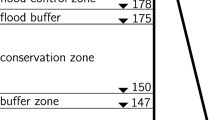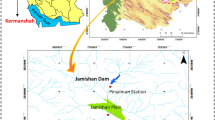Abstract
A simulation-optimization procedure is presented for evaluating the extent of interbasin transfer of water in the Peninsular Indian river system consisting of 15 reservoirs on four river basins. A system-dependent simulation model is developed incorporating the concept of reservoir zoning to facilitate releases and transfers. The simulation model generates a larger number of solutions which are then screened by the optimization model. The Box complex nonlinear programming algorithm is used for the optimization. The performance of the system is evaluated through simulation with the optimal reservoir zones with respect to four indices, reliability, resiliency, vulnerability and deficit ratio. The results indicate that by operating the system of 15 reservoirs as a single unit the existing utilization of water may be increased significantly.
Similar content being viewed by others
Abbreviations
- DEF L t :
-
deficit in reservoir L in periodt
- DEM k t :
-
existing irrigation demand at reservoirk in periodt
- DIV k t :
-
diversion from reservoirk in periodt to meet its own demand
- D k t :
-
deficit in reservoirk in periodt
- d k t :
-
water demand at reservoirk in periodt
- F :
-
failure index
- I k t :
-
natural inflow to reservoirk in periodt
- INCR:
-
factor by which irrigation demands are multiplied (≥ 1.0)
- INCR1k :
-
factor by which the monsoon irrigation demands at reservoirk are multiplied (≥ 1.0)
- INCR2k :
-
factor by which the nonmonsoon irrigation demands at reservoirk are multiplied (≥ 1.0)
- j :
-
season index;j = 1 for monsoon season andj = 2 for nonmonsoon season
- L:
-
index for the reservoir to which a release from reservoir M is possible
- M:
-
index for the current reservoir (reservoir from which releases and transfers are being computed)
- P:
-
index for the reservoir to which a transfer from the reservoir M is possible
- R M,L t :
-
release from reservoir M to reservoir L in periodt
- S M1t :
-
storage at reservoir M in periodt after accounting for diversions and releases
- S k it :
-
storage at the beginning of periodt in reservoirk
- S L t :
-
storage in reservoir L in periodt after accounting for transfers and releases already committed to reservoir L from reservoirs other than the reservoir M
- S MAX :
-
maximum storage
- S MIN :
-
minimum storage
- S REL :
-
storage level above which a release is allowed
- S REL,j :
-
storage level at a reservoir for the seasonj above which release from the reservoir is allowed
- S MREL,j :
-
storage level of reservoir M in seasonj, above which release from reservoir M is allowed
- S TRA :
-
storage level above which a transfer is allowed
- S TRA,j :
-
storage level at a reservoir for the seasonj above which transfer from the reservoir is allowed
- S MTRA,j :
-
storage level of reservoir M in seasonj above which transfer is allowed
- t :
-
period index
- T i :
-
target in periodi
- T M,P t :
-
amount of water transferred from reservoir M to reservoir P in periodt
- U k t :
-
amount of water utilised from reservoirk in periodt
- γ :
-
resiliency
- Δ i :
-
deficit in periodi
- δ :
-
deficit ratio
- v :
-
vulnerability
- ρ :
-
reliability
References
Box M J 1965 A new method of constrained optimisation and a comparison with other methods.Comput. J. 8: 42–52
Beard L R 1967 Functional evaluation of a water resources system.Int. Conf. Water for Peace, Washington DC, pp 23–31
Chaturvedi M C, Srivastava D K 1981 Study of a complex water resources system with screening and simulation models.Water Resour. Res. 17: 783–794
Chung I, Helweg O 1985 Modeling the California State Water Project.J. Water Resour. Plann. Manage., ASCE 111: 82–97
Fiering M B 1982 Estimates of resilience indices by simulation.Water Resour. Res 18: 41–50
Hashimoto T, Stedinger J R, Loucks D P 1982 Reliability, resiliency, and vulnerability criteria for water resource system performance evaluation.Water Resour. Res. 18: 14–20
Jacoby H D, Loucks D P 1972 Combined use of optimisation and simulation models in river basin planning.Water Resour. Res. 8: 1401–1414
Joeres E F, Liebman J C, Revelle C S 1971 Operating rules for joint operation of raw water sources.Water Resour. Res. 7: 225–235
Kuo J T, Hsu N S, Chu W S, Wan S, Lin Y J 1990 Realtime operation of Tanshui River reservoirs.J. Water Resour. Plann. Manage. ASCE 16: 349–361
Matalas N C 1967 Mathematical assessment of synthetic hydrology.Water. Resour. Res. 3: 937–945
Ministry of Irrigation 1980 Government of India, National perspectives for water resources development.Proceedings of International Symposium on Water Resources System, University of Roorkee, Roorkee
Razavian D, Bleed A S, Supalla R J, Gollehon N R 1990 Multistage screening process for river basin planning.J. Water. Resour. Plann. Manage., ASCE 116: 323–334
Sigvaldason O T 1976 A simulation model for operating a multipurpose multireservoir system.Water Resour. Res. 12: 263–278
Simonovic S P 1987 The implicit stochastic model for reservoir yield optimisation.Water Resour. Res. 23: 2159–2165
Author information
Authors and Affiliations
Corresponding author
Rights and permissions
About this article
Cite this article
Vijay Kumar, V., Rao, B.V. & Mujumdar, P.P. Optimal operation of a multibasin reservoir system. Sadhana 21, 487–502 (1996). https://doi.org/10.1007/BF02745571
Revised:
Issue Date:
DOI: https://doi.org/10.1007/BF02745571




